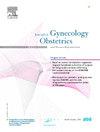Predictors for the efficacy of methotrexate and mifepristone treatment in ectopic pregnancy
IF 1.6
4区 医学
Q3 OBSTETRICS & GYNECOLOGY
Journal of gynecology obstetrics and human reproduction
Pub Date : 2025-08-29
DOI:10.1016/j.jogoh.2025.103022
引用次数: 0
Abstract
Objective
To compare the efficacy of methotrexate (MTX) alone versus MTX plus mifepristone for stable ectopic pregnancy, identify predictors of treatment success, and explore outcome-prediction models.
Methods
We conducted a retrospective, two‑arm observational cohort of consecutive patients with stable ectopic pregnancy treated in routine care (MTX‑only n = 138; MTX+mifepristone n = 132). Treatment assignment was non‑randomized, reflecting clinician judgment and patient preference. Baseline characteristics and treatment details were recorded, and the primary outcome—resolution of the EP without surgery—was assessed. Predictive factors were analyzed via logistic regression with Hosmer–Lemeshow testing for calibration. We further evaluated advanced machine learning models to classify treatment success.
Results
Overall treatment success rates were 73.91% (MTX-only) and 78.79% (MTX plus mifepristone), with no statistically significant difference between groups (p = 0.38). Across the combined cohort, factors strongly predicting success included initial hCG <1500 mIU/mL (adjusted OR 2.70, p = 0.01), absence of fetal cardiac activity (adjusted OR 2.10, p = 0.04), lower gestational age at diagnosis (adjusted OR 0.82 per week, p = 0.02), and a ≥ 15% hCG decline by Day 4 (adjusted OR 2.40, p = 0.02). By location, success rates were similar in tubal and non‑tubal strata. The treatment × location interaction was not significant (p = 0.85), and tubal‑only results were unchanged. The multivariable logistic regression predicting treatment success vs failure showed good discrimination (AUC 0.82) and adequate calibration (Hosmer–Lemeshow p = 0.45). In exploratory benchmarking of algorithms trained to predict success vs failure on the same predictors, gradient boosting yielded the highest apparent discrimination (accuracy 84%; AUC 0.88) in this dataset.
Conclusions
MTX plus mifepristone did not significantly outperform MTX alone in resolving stable ectopic pregnancy. Key predictors of successful medical management included lower baseline hCG levels, earlier gestational age, and substantial early hCG declines. Advanced machine learning approaches may improve predictive accuracy, supporting more individualized treatment selection for ectopic pregnancy.
甲氨蝶呤和米非司酮治疗异位妊娠疗效的预测因素。
目的:比较甲氨蝶呤(MTX)单用与MTX联合米非司酮治疗稳定异位妊娠的疗效,确定治疗成功的预测因素,探索结果预测模型。方法:我们对连续接受常规治疗的稳定异位妊娠患者进行回顾性、两组观察队列研究(仅使用MTX的患者138例;MTX+米非司酮的患者132例)。治疗分配是非随机的,反映了临床医生的判断和患者的偏好。记录基线特征和治疗细节,并评估主要结果-不手术的EP缓解情况。采用Hosmer-Lemeshow检验对预测因素进行logistic回归分析。我们进一步评估了先进的机器学习模型来对治疗成功进行分类。结果:总治疗成功率分别为73.91%(单用MTX)和78.79% (MTX联合米非司酮),组间比较差异无统计学意义(p=0.38)。在整个联合队列中,预测成功的因素包括最初的hCG结论:甲氨喋呤加米非司酮在解决稳定异位妊娠方面没有明显优于单用甲氨喋呤。成功医疗管理的关键预测因素包括较低的hCG基线水平、较早的胎龄和早期hCG的显著下降。先进的机器学习方法可以提高预测的准确性,支持更个性化的异位妊娠治疗选择。
本文章由计算机程序翻译,如有差异,请以英文原文为准。
求助全文
约1分钟内获得全文
求助全文
来源期刊

Journal of gynecology obstetrics and human reproduction
Medicine-Obstetrics and Gynecology
CiteScore
3.70
自引率
5.30%
发文量
210
审稿时长
31 days
期刊介绍:
Formerly known as Journal de Gynécologie Obstétrique et Biologie de la Reproduction, Journal of Gynecology Obstetrics and Human Reproduction is the official Academic publication of the French College of Obstetricians and Gynecologists (Collège National des Gynécologues et Obstétriciens Français / CNGOF).
J Gynecol Obstet Hum Reprod publishes monthly, in English, research papers and techniques in the fields of Gynecology, Obstetrics, Neonatology and Human Reproduction: (guest) editorials, original articles, reviews, updates, technical notes, case reports, letters to the editor and guidelines.
Original works include clinical or laboratory investigations and clinical or equipment reports. Reviews include narrative reviews, systematic reviews and meta-analyses.
 求助内容:
求助内容: 应助结果提醒方式:
应助结果提醒方式:


